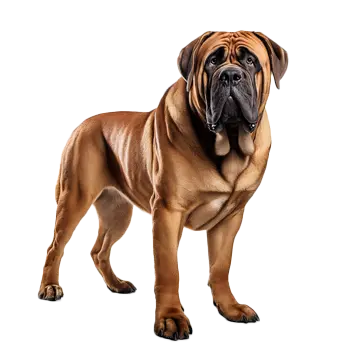The Mastiff presents one of the most imposing physical presences in the canine world, with males typically standing 30 to 31 inches at the withers and weighing between 160 to 230 pounds, while females measure 27.5 to 28 inches tall and weigh 120 to 170 pounds. However, these measurements represent minimums, and exceptional specimens frequently exceed these parameters. The breed is characterized by massive bone structure, great depth and breadth of body, and substantial musculature that creates an impression of immense power combined with surprising agility for such a large animal.
The head exemplifies the breed's grandeur, appearing massive from any angle with exceptional depth and breadth. The skull is broad between the ears, somewhat flattened but showing pronounced wrinkles when the dog is attentive or alert. The stop is moderately defined, and the muzzle, while short in proportion to the skull (approximately one-third the length of the entire head), maintains substantial width and depth throughout its length with minimal tapering toward the nose. The lips are pendulous, creating the characteristic jowls that extend well below the lower jaw, though excessive looseness is penalized. The nose must be broad, flat, and dark in color, complementing the required black mask that extends over the muzzle, around and over the eyes, and onto the ears.
Eyes are set wide apart, medium in size, and never protruding. Color should be dark brown, with darker shades preferred. The expression combines alertness with inherent nobility and kindness, reflecting the breed's dignified temperament. Ears are relatively small in proportion to the skull, V-shaped with rounded tips, and set high on the head at the corners of the skull. They should lie flat and close to the cheeks when at rest, becoming slightly raised and forward when the dog is alert, emphasizing the facial wrinkles.
The body demonstrates the breed's powerful build with a massive, deep, wide chest that extends well down between the forelegs. Ribs are well-sprung and rounded, providing substantial lung capacity. The back is straight and muscular, neither roached nor swayed. The loin is wide and muscular, while the croup is slightly sloping. Overall body length from point of shoulder to point of buttock is moderately greater than height at withers, creating a rectangular rather than square profile. The tail is set high, thick at the root, and tapering to the tip. It hangs straight down when at rest and rises to level with the back or slightly above when the dog is alert, though never curled over the back.
Forequarters show substantial bone and muscle. Shoulders are moderately sloping, powerful and muscular but not loaded. Legs are straight, strong, and set wide apart, with heavy bone throughout. Feet are large, round, and compact with well-arched toes and dark nails. Hindquarters are broad, wide, and muscular with well-developed second thighs. The stifle joint is moderately bent, and hocks are well let down and parallel when viewed from behind. Rear feet are slightly smaller than front feet but equally compact.
The coat is short, straight, and coarse in texture, lying flat against the body. The undercoat is dense and shorter. The coat should never be long, silky, or wavy. Colors include apricot-fawn, silver-fawn, fawn, or dark fawn-brindle. The fawn colors range from very light silver to deep red-gold, with brindle showing fawn background with darker stripes. The black mask is essential and should be clearly defined, extending up between the eyes. Ears should be dark, and darker body color is generally preferred. Small white markings on the chest are permissible but not desired.
Affectionate With Family
★★★★★
The Mastiff forms extraordinarily deep bonds with family members and demonstrates profound devotion. Despite their imposing size, they are gentle and loving with their people, often seeking physical closeness and displaying remarkable patience with household members of all ages.
Good With Young Children
★★★★★
Mastiffs are exceptionally patient and gentle with children, often serving as devoted guardians and companions. Their calm demeanor and protective instincts make them wonderful family dogs, though supervision is recommended due to their massive size which could accidentally knock over small children.
Good With Other Dogs
★★★☆☆
With proper socialization from puppyhood, Mastiffs can coexist peacefully with other dogs. They are typically not aggressive but their size and protective nature require careful introductions. Some males may display dominance with same-sex dogs, particularly if not neutered.
Shedding Level
★★★☆☆
Mastiffs shed moderately throughout the year with heavier shedding periods during spring and fall. Their short coat sheds consistently but is manageable with regular brushing. Weekly grooming helps control loose hair and keeps their coat healthy.
Coat Grooming Frequency
★★☆☆☆
The Mastiff's short, dense coat requires minimal grooming compared to many breeds. Weekly brushing with a rubber curry brush or hound glove removes loose hair and distributes natural oils. Special attention should be paid to facial wrinkles which require regular cleaning.
Drooling Level
★★★★★
Mastiffs are prolific droolers, particularly after eating, drinking, or when excited. Their loose jowls produce substantial amounts of drool that owners must be prepared to manage. Keeping towels handy and wiping their face regularly becomes part of daily life.
Coat Type
★☆☆☆☆
The Mastiff possesses a short, straight, coarse-textured outer coat lying flat against the body with a dense, shorter undercoat. This relatively simple coat provides adequate protection against various weather conditions while remaining easy to maintain compared to long-haired breeds.
Openness To Strangers
★★☆☆☆
Mastiffs are naturally aloof and reserved with strangers, observing newcomers with dignified suspicion. While not aggressive without cause, they take their guardian role seriously. Early socialization helps them distinguish between welcome guests and genuine threats, developing appropriate responses.
Playfulness Level
★★☆☆☆
Adult Mastiffs exhibit moderate playfulness, preferring brief play sessions to extended romping. Puppies are more energetic and playful, but as they mature, Mastiffs develop a more sedate, dignified demeanor. They enjoy gentle games and interactive time with family.
Watchdog/Protective Nature
★★★★★
The Mastiff's protective instincts are legendary, bred through centuries as guardians of estates and families. They are naturally vigilant and territorial, typically responding to threats with imposing presence rather than aggression. Their size alone provides formidable deterrence to intruders.
Adaptability Level
★★☆☆☆
Mastiffs adapt best to stable environments with consistent routines. Their massive size requires substantial living space, making apartment living challenging. They struggle in hot climates due to their short muzzles and heavy body mass, requiring climate-controlled environments during warm weather.
Trainability Level
★★★☆☆
Mastiffs are intelligent and capable of learning but can display independent thinking and occasional stubbornness. They respond best to patient, consistent training using positive reinforcement. Early socialization and obedience training are essential, as their size makes control crucial for safety.

